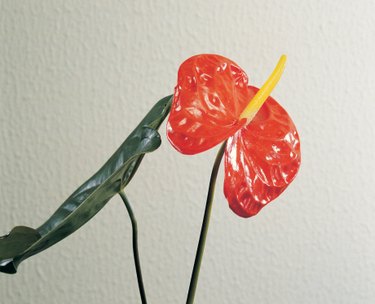
Anthuriums are tropical flowers with dark green, heart-shaped leaves, which may be why they're also known as the Hawaiian love plant. Their showy red, pink and white flowers aren't actually flowers at all, but modified leaves known as spathes. The true flowers grow on a fleshy spike in the center of the plant, surrounded by the spathes. Anthuriums are fairly easy to grow, but they are subject to a number of diseases that can kill them.
Anthracnose
Video of the Day
Anthracnose is a fungal infection that can be recognized by the tiny brown spots that appear on the spadix, which is the fleshy spike surrounded by the spathes. The spots grow bigger and look water-soaked when it's humid. In severe cases, batches of orange spores will form on the dead spots. Leaves, including the spathes, aren't usually affected. Control anthracnose with applications of mancozeb and benomyl fungicides.
Video of the Day
Blight
The bacteria responsible for bacterial blight usually enters the plant through microscopic pores found on the edges of the leaves. Yellowish, water-soaked spots appear on the leaf margins. The spots grow slowly but can eventually spread to cover the entire edge and center of the leaf. Older lesions are black with a bright yellow border. A serious infection can result in the entire plant turning yellow and dying. Remove diseased leaves and avoid watering plants from overhead to reduce the spread of blight.
Root Rot
Plants infected with the fungi that causes root rot have leaves that turn yellow or pale green, wilt and die. In addition, the plants are stunted. An inspection of the roots reveals small water-soaked lesions that are gray or brown. These lesions cause the roots to rot and can destroy your anthurium's entire root system. Applying fungicides can help control the spread of root rot. Avoid root rot problems by providing plants with good drainage and ventilation.
Wilt Virus
Tomato spotted wilt virus attacks several plants besides tomatoes, including anthuriums. Tiny insects called thrips spread this disease. Symptoms include the appearance of small, yellowish-green patches on the leaves. The patches can be faint and hard to see. As the disease proceeds, they turn into yellowish spots with brown pitting. The brown areas grow bigger, and the bottom sides of the leaves also turn yellow. Young leaves and flowers that are infected also have water-soaked spots that look like bacterial blight but don't ooze like bacterial blight. Destroy diseased plants and use an insecticide to control thrips that are responsible for spreading this disease.
Overwatering
Overwatering contributes to disease problems in anthuriums. According to Dr. Rick Schoellhorn, a former specialist with the University of Florida Extension, there is a misunderstanding among some gardeners that anthuriums need a lot of water, but that's not true. Plants that are overwatered are more susceptible to fungal problems like root rot. After a thorough watering, let the soil dry out before watering your plant again. Anthuriums also need good drainage, which can be achieved by planting them in a mixture of peat, composted pine bark and perlite.
- University of Florida Extension: Tropical Anthuriums for Holiday Color
- Virginia Wesleyan College: An Anthurium Farm - Floral Resources/Hawaii, Inc.
- Virginia Wesleyan College; Tomato Spotted Wilt Virus On Anthurium; Janice Y. Uchida, et al.; June 1999
- University of Florida: Anthurium Production Guide
- University of Illinois Extension Report On Plant Disease; Bacterial Diseases of Anthurium, Dieffenbachia, Philodendron, and Syngonium; September 2001
- Florida State Horticulture Society; Anthurium and Aglaonema Production In Dade County, Florida; Dearmand L. Hull, et al.; 1995
- University of Hawaii; Identifying Anthurium Flower Injuries; Brian C. Bushe, et al.; April 2004
- Clemson Extension; Index Of Plant Diseases In South Carolina; James H. Blake, Ed. D., et al.